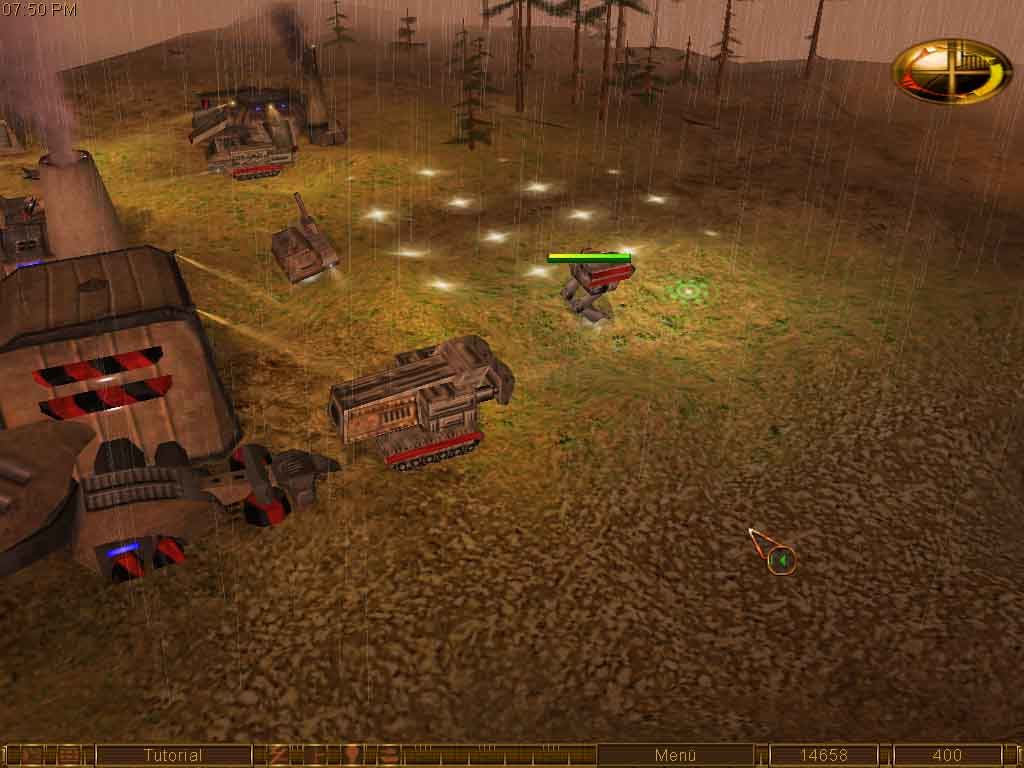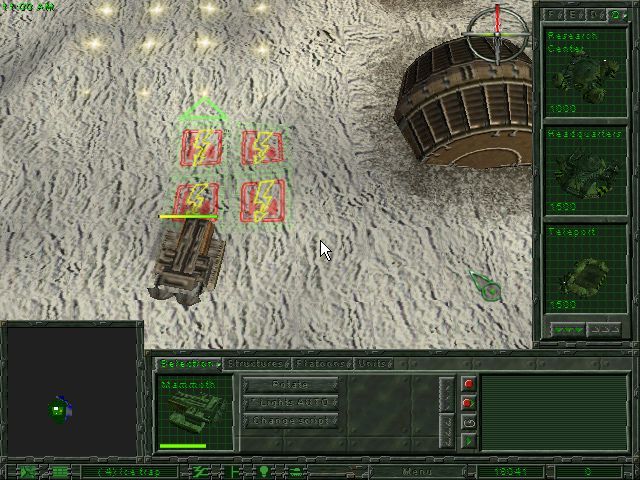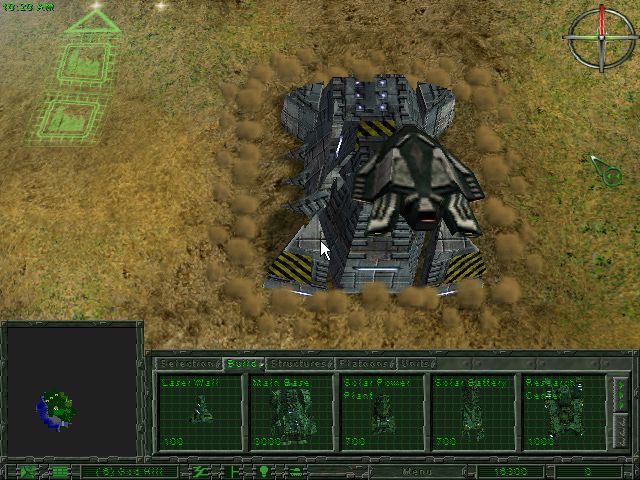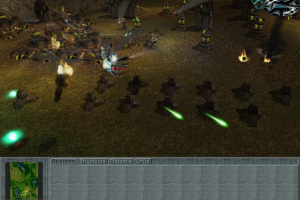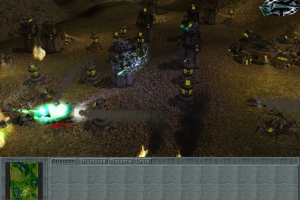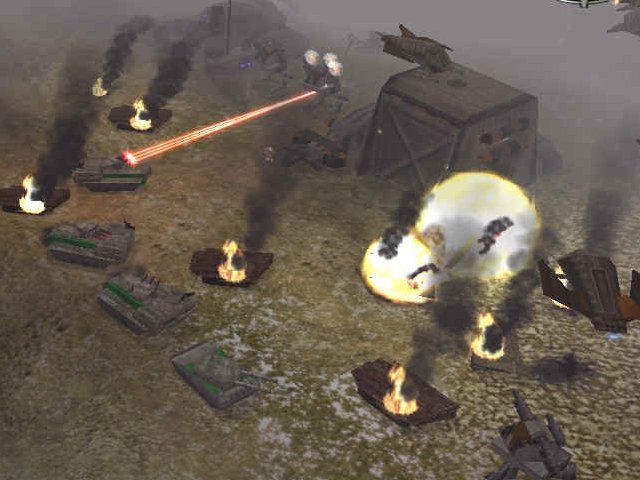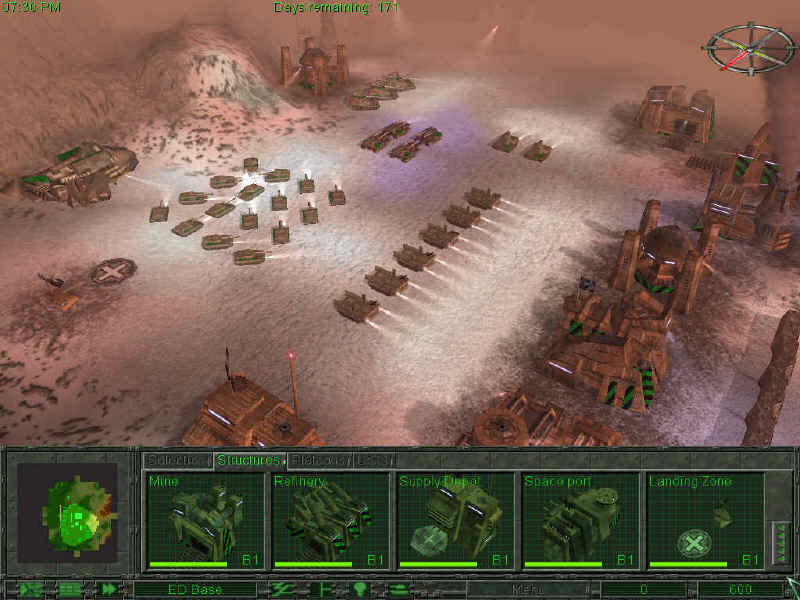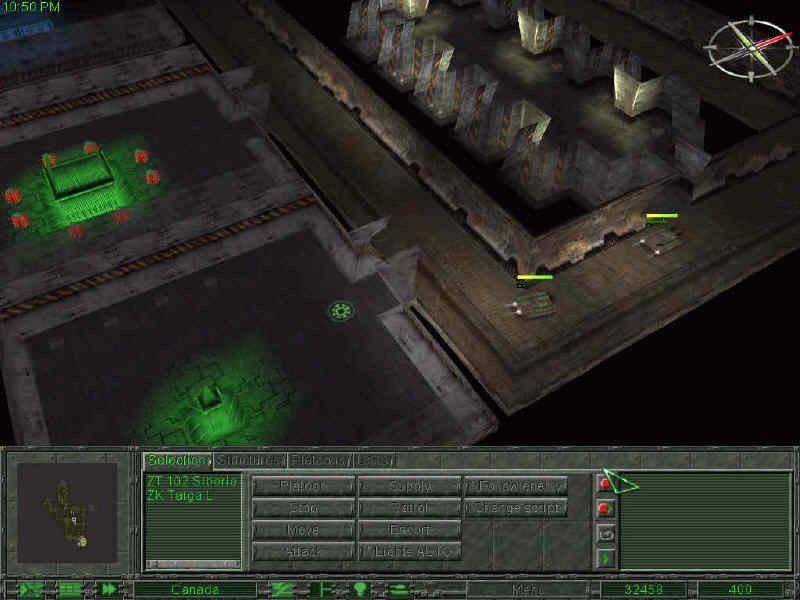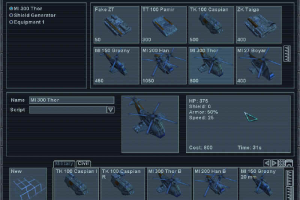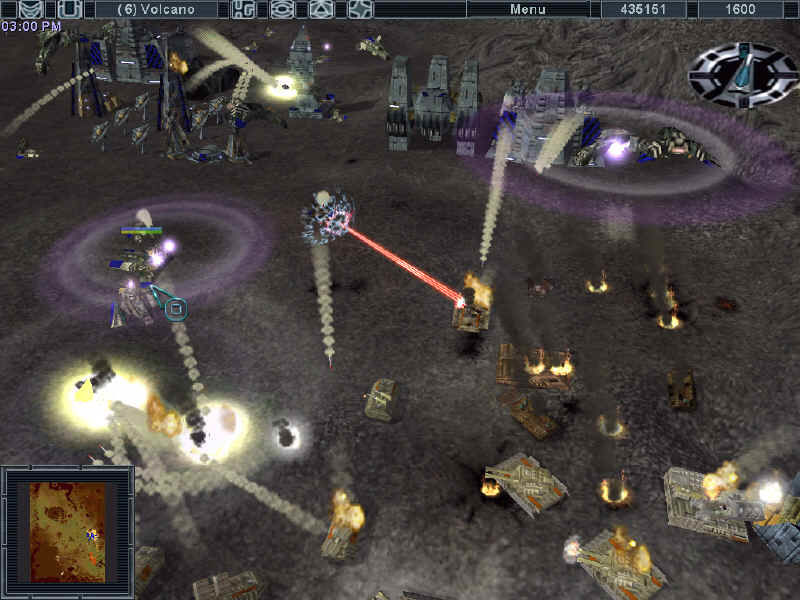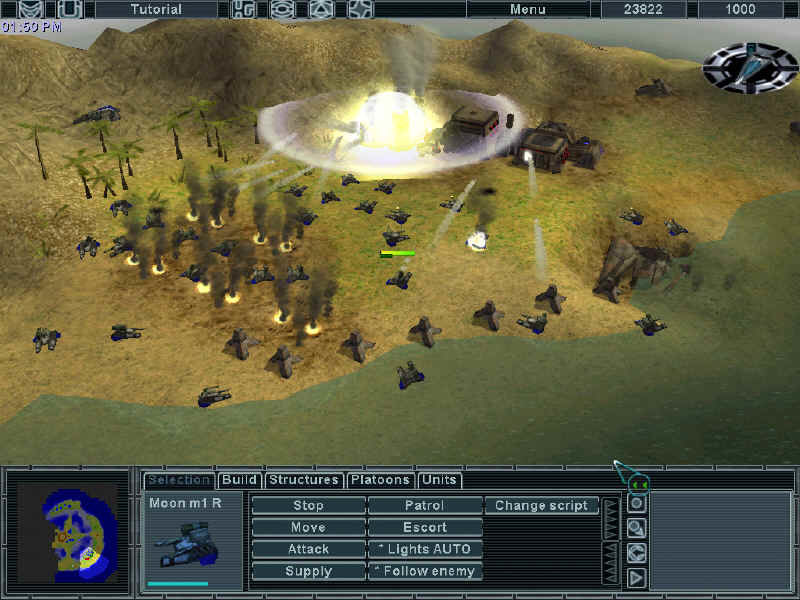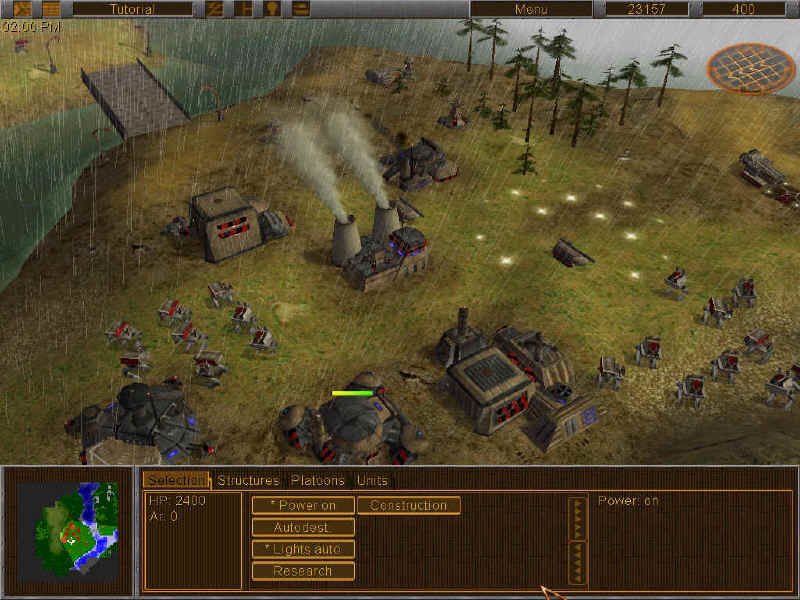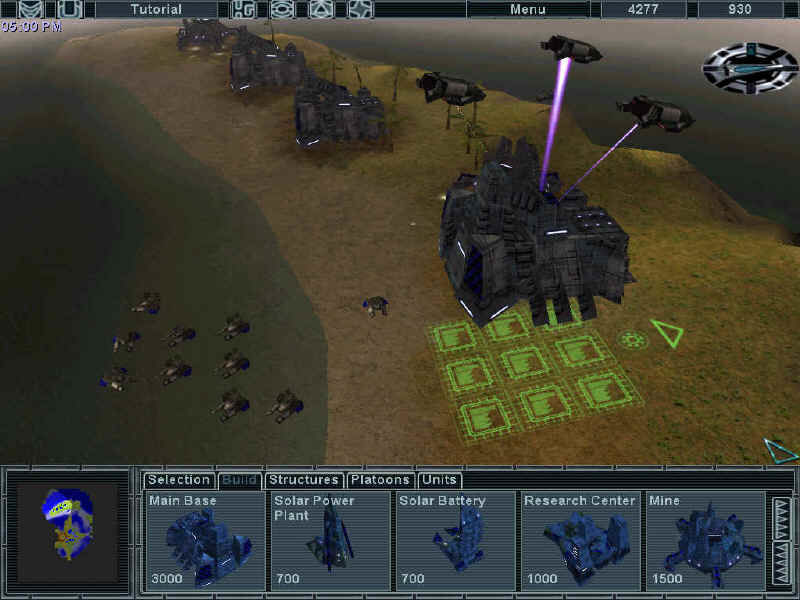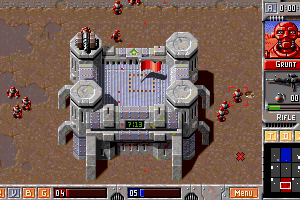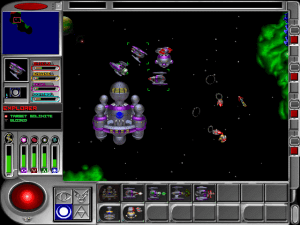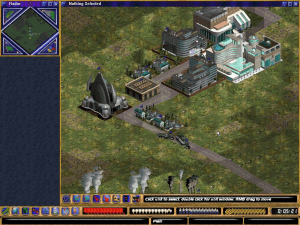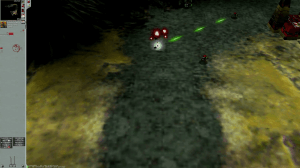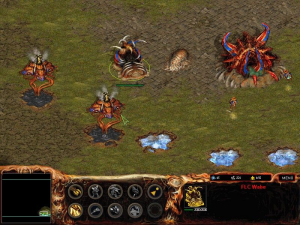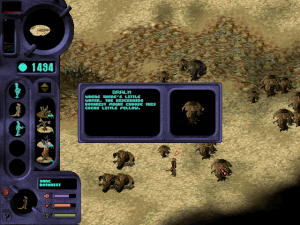Earth 2150
Windows - 2000
Description of Earth 2150
Real Time Strategy seems to be the order of the day at the moment with a constant stream of new releases hot on the heels of one another. The majority of these seem to follow the 3D bandwagon with lots of polygons and a free-floating camera. The difficult task facing developers and publishers is to transplant the quality and playability offered by established 2D isometric titles to the 3D world. A tricky operation, it would seem, considering some of the dismal attempts thus far. From a sci-fi setting, perhaps the closest we've come to date is Warzone 2100. Ground Control caught my attention also, though I would argue that this is more of a 3D action game. Earth 2150, already a big hit in its native Germany, is not radically different from its predecessors, but it does offer an incredible depth of gameplay and succeeds in smoothing out many of the rough edges found in other 3D titles.
Looking at the setting for Earth 2150 it has to be conceded the story is fairly standard sci-fi fare. As the title indicates, we find ourselves in the middle of the 22nd century, where the inhabitants of Earth are divided into three belligerent factions; the United Civilized States (UCS), the Eurasian Dynasty (ED) and the Lunar Corporation (LC). The existence of these groups has been brought about by a combination of economic collapse and global conflict, ultimately resulting in the displacement of Earth from its axis following the use of nuclear weapons. As a result, the Earth and the Moon are now on a collision course with the Sun and the three sides find themselves fighting a race against time to build an evacuation fleet to escape the catastrophe. This explains the sub-title, Escape from the Blue Planet.
Despite its familiar feel, developers Topware Interactive are clearly committed to this story; they have created an extensive history and identity for each faction and are planning a complete series of games around the concept, with two more currently under development. The Moon Project is set in a parallel time frame to Earth 2150 and sees the fighting moving to urban settings and the Moon. Earth III is a sequel in which we will see the three factions, by now relocated to Mars, uniting to vanquish an alien invader. Earth 2150 is a sequel itself, following on from the relatively unsuccessful Earth 2140, which was overshadowed by more worthy competition. In fairness, Earth 2150 does try to be different and the German/Polish development team has worked hard to inject some innovation.
The game is truly massive and offers three campaigns, a skirmish and multiplayer mode. Each faction campaign comprises 25 separate missions and could be seen as being a game in itself. As well as having to complete individual mission goals, there is an overriding objective to raise 1,000,000 credits needed to build the evacuation fleet. If that wasn't difficult enough, there are only 183 days remaining before Earth disintegrates under the Sun's heat. This combination of campaign and mission goals forces the player to consider strategy as well as tactics and sets the game above many of its contemporaries. The missions adopt a non-linear system, though it is not always clear what the advantages of conquering a particular area or copying data from an opponent's computer core are. They are also fairly scripted with key events triggering further activities.
To generate the necessary cash, the factions have to mine ore from mineral deposits on the Earth's surface. There is no market as such; simply mining and refining the raw material provides the necessary funding. Everything in the game has an associated cost in credits. The only other resource of consequence is energy. Depending on the faction you decide to play as, this is provided by a nuclear or solar power plant. The plants themselves have limited range, though constructing transmitter devices can mitigate this constraint. Naturally, the supply of solar energy is limited by the day-night cycle and environmental conditions such as cloud cover - no sun, no energy. It therefore advisable to construct batteries for contingency. Because of the significance of power, destroying your opponents power network can render them helpless, allowing you to sweep in and lay waste to their static defences before they have a chance to restore it.
A Juggling Act
You start the campaign from a main base, complete with key structures such as a power plant and vehicle production centre. Units are manufactured by such purpose-built structures at a pre-set cost and can be queued continuously or for a specific number. Typically, you start each mission with a construction unit at your disposal. This allows you to build a landing zone to bring in more units from your main base by means of a drop ship. As well as transporting units, the drop ship can be loaded with credits. Almost invariably you will need to locate a resource field and begin mining operations as soon as possible. In the case of ED this is carried out by a conventional mining/refining process, which requires two specific structures to be built. Ore is transported from the mine to the refinery by transportation units. The refinery processes the ore and turns it into credits which can be used to research new technologies, fund the evacuation fleet project, or build more structures and units (either at the main base or mission base, or both). The most crucial building of all is the space port. This is located at your main base and used to store the credits for fleet construction. A number of defensive structures are available including construction options such as walls, bridges, trenches, and tunnels. The latter is an interesting development and opens up a number of interesting opportunities and tactics. For instance, you can hide your forces from the prying eyes of enemy scouts and use tunnel networks to sneak up and outflank your opponent. Some missions feature caverns which can be connected to tunnels to save valuable resources.
Unit pathfinding was noticeably strong when navigating some of these labyrinths, always taking the most direct route. Surface pathfinding is also excellent, no annoying unit pile ups! Credit should be given here as this a common problem area for many games. When attacking, the AI adopts the ubiquitous multiple wave approach. Refreshingly, I've also experienced more commendable tactics such as surprise attacks whilst in the middle of my own assault. The enemy AI tends to target crucial structures such as power plants and all units are quick to join nearby action rather than sit around, TA: Kingdoms style.
Whilst your ultimate objective is to fund the evacuation fleet it is always sensible to hold some credits back until you know you have completed all of your mission goals. Some of the missions have a nasty habit of springing a new and even more demanding objective on you just as you think you've succeeded. If you've exploited all available mineral deposits and transferred your credits to the space port you're going to find it difficult to complete the mission. When you have finally completed all objectives, it's time to vacate the area, pronto, and return to the main base. Withdrawing your forces with the drop ship can be a little tiresome after a while but the alternative would be to produce them all over again and use up valuable resources. Worse still, any combat experience the units had gained would be lost and you'd be starting out again with rookies. Another important feature of the game is the logistic support. Not only do you have to provide the daunting amount of resources to build the evacuation fleet but you also have to keep your units armed and maintained. There are a number of different ways to do this depending on the faction but the basic premise is the same.
Meteorological Magic
The two most innovative aspects of Earth 2150 are the weather effects and day-night cycle. These work together to provide a new strategic dimension and help to give you the impression of 'being there'. Precipitation is buffeted by the wind and directly impairs your ability to manoeuvre, move speedily or launch aircraft. Similarly, fog can roll in and reap havoc. And as the Earth heads ever closer to the Sun the ice cover starts to melt. The day-night cycle literally takes you through a 24 hour clock, albeit at an accelerated rate. These types of effect force you to consider your strategy carefully. In a night attack, switching off your unit lights can give you the advantage of surprise, though this tactic can be risky as it is easy to lose control of the situation, as is the case in reality. It is important to maximise the limited daylight hours, particularly in favourable weather conditions.
Cultivating the Technology Tree
As with many RTS games, research is an integral part of gameplay. Earth 2150 is no exception and in many ways is the single most important aspect to winning or losing the game. The task of researching new technologies can be carried out manually or assigned to a headquarters unit (a kind of micro-management assistant which can automate other functions such as construction, defence and upgrades). Either way, research largely revolves around the development of unit chassis designs, ballistic technology and super weapons. Many RTS games provide their opposing factions with similar unit types, whereas Earth 2150 succeeds in moving away from this approach and creating diverse units which not only look different but have different characteristics as well. Each faction has a number of exclusive technologies, e.g. the ED have the ion cannon, radar, missile control centres and atomic weapons; the UCS have anti-gravity propulsion, plasma cannons/bombs and a teleport; and the LC have sonic weapons, solar power and weather control capability - enabling them to stir up all kind of nasty surprises such as lightning and meteor storms.
The tree itself is fairly extensive and increasingly expensive options become available the higher you get. When designing and deploying weapons systems you need to consider speed, manouverability, shield strength, effective range, impact and reload characteristics. Because of the associated cost of research, it is critical to strike the right balance between developing new technology, maintaining sufficient combat and support units and completing the evacuation fleet on schedule. A tall order indeed. Skimping on research in a bid to save money is sure to end in disaster your units will quickly become obsolete. Conversely, investing time and money into producing heavily armed and armoured units does not guarantee you victory as a larger number of medium tech units could still win the day.
The single most restrictive factor of all though is the unit credit limit rule. In campaign play, the combined value of military units that can be deployed at any one time cannot exceed an automatically determined figure, initially 10,000 credits. Early in the game, a military unit can cost as little as 600 credits but later on, this can rise to as much as 5,000! This severely impairs your ability to mass-produce units as would be the case in Total Annihilation. Instead, you must focus on repairing your existing units and relying on their increased experience and technology upgrades to survive. Depending on your personal preference, this restriction will or won't appeal. No doubt there will be a cheat to resolve this feature but I'd have preferred the setting to be higher or configurable, as is the case in skirmish and multiplayer mode. As new technologies become available you can either upgrade or construct new unit designs. This is very easy to do and follows a common approach found in games such as Warzone 2100 and Alpha Centauri. The resultant combinations can be similar but there are enough chassis/air frame designs available to create diverse and distinguishable units. These tend to be land and air based but there are also amphibious and naval units for good measure. A number of fake units can be mass produced inexpensively and used as decoys to distract enemy fire whilst you target key installations and emplacements.
Some might find the time it takes to develop a technology and manufacture a unit frustrating. Depending on the item being researched, this can be anywhere between one and fifteen minutes - significantly longer than games such as Age of Empires. But when you consider the day-night cycle, even the longest periods represent only a few days in equivalent time. Building more research centres can increase the turnaround, though three is the optimum number. Construction is relatively quick in comparison but it often pays to construct several vehicle and weapon production structures to speed up the process.
The Camera Eye
A wide range of floating camera control interfaces have been employed in RTS games and most of them seem to make hard work of what should be an easy task. Earth 2150 succeeds where others have failed by using a very intuitive system. Moving the mouse pointer to the edge of the screen will automatically move the camera left/right or forwards and backwards. Move the pointer away from the edge and the camera will stop. To rotate the camera horizontally, you simply press and hold down the right mouse button and rotate the camera in relation to the lateral motion of the mouse. Vertical angles are achieved in the same way but using a forwards and backwards motion. Zooming in and out is controlled by holding down both mouse buttons simultaneously and dragging forwards and backwards. Camera aspect lock can be applied to a specific unit or group, providing a chase view capability, particularly useful for scouting and reconnaissance missions. I would have preferred to be able to angle the camera down to ground level but this is not possible. The keyboard can be used to replicate the mouse control movements, so you have the choice of either device or a combination of the two. This is a better system than Ground Control, which forces you to use both the mouse andkeyboard.
Interface 'U' Like
The main game screen is efficiently designed, sharply presented and easily accessible. This is a major step forward for the 3D RTS genre. Each faction has a choice of luminous or solid display, making a total of six options. Any one of these can be used, regardless of the faction you are playing and the display can be changed mid-game if you feel so inclined. I think this is a feature which developers should include more often as there is relatively little development overhead in implementing it and it serves to reinforce the separate identity of factions as well as present the player with an aesthetic choice. The main screen comprises a toolbar, panel, mini-map, compass and console, the majority of which can be positioned as preferred. Specific information read-outs are available for structures, units, platoons and selections. These are displayed on the panel and provide the main command and control interface, allowing the quick location of any structure or unit in your command without having to scout the map for it. The toolbar details your energy and money status as well as containing icons to other screens such as the construction and research centres. Another big plus is the way in which you can control units, platoons and groups. You can create any combination from a single unit to a extensive battle group. Unit and structure selection/de-selection is controlled by left mouse clicking an individual item or 'swiping' an area with the left-mouse button depressed. Double left-mouse clicking a selected unit automatically selects all units of a similar type. The typical set of actions such as move, stop, attack, escort and patrol are featured but in addition there are unit and structure specific commands such as capture, repair, reload, rotate, supply, and rather bizarrely, repaint! Yes, you can actually use the repairer unit to repaint the identification colours of your units and structures. Novel indeed. Most structures have a self-destruct feature which can be deactivated during a ten second countdown if you click in error or change your mind. Fundamentally linked to the day-night cycle and weather effects are the structure lighting and unit headlights. These are delightfully detailed and really give a sense of realism. They can be controlled manually or set to automatically switch on and off depending on the visibility conditions.
Unit behaviour is controlled in two ways. All units are assigned a script, ranging from construction unit to minelayer. These are generally distinct, though I have to admit to being less than clear about the difference between battle unit, simple battle unit and advanced battle unit. The scripts can be changed as required and applied when creating new units based on technological developments. In addition to the scripts, military units also have a doctrine setting such as hold position, follow enemy, static attack, dynamic attack, slow, average and fast.
There are also two auxiliary camera windows which provide the same functionality as the main window, thus allowing you to view and issue commands from up to three separate perspectives. So, you can set one window to keep an eye on your main base whilst you work on a mission with another and use the third for surveillance purposes, e.g. a tunnel system. You can swap views from the main window to the auxiliary windows and vice versa. This all takes a little bit of getting used to but is worth persevering with. The interface provides many other features such as way-points, factory destination assembly points and the all important in-mission save. You can even continue to issue orders during pause mode and there are a number of useful visual aids, including power plant coverage ranges and the position of tunnels from a ground level perspective. Hotkeys are provided for virtually every command and these are completely configurable. The range of option settings is notably extensive; everything from game speed to gamma settings can be adjusted.
Skirmishes 'R' Us
Skirmish mode offers three different game types :-
Uncle Sam - an action-all-the-way option with no resource gathering whatsoever. The objective is to wipe out your opponents. To assist you in this goal, you are allotted credits at the predefined frequency and rate.
Kill 'Em All - has nothing to do with Metallica. It is the classic death match variant with loads of money to start with.
Destroy Structures - similar to death match but with the objective of destroying your opponents structures. I had a few close shaves with this one, desperately trying to start a new base with a single crucial structure just as your previous base is on the verge of being annihilated.
Once you have decided which type of match you want to play you have a wide range of options to configure. These include starting money, cash rate, rate frequency, starting units, unit credit limit, time and resource levels, and random positioning. Faction choice can be manually set or randomised, including an option to exclude any one faction from the random selection. Not surprisingly, I found the skirmish mode far more accessible than the single player campaigns and revelled in the ability to produce more units. Each faction is generally well balanced and no one opponent has a significant advantage over another. Even the Eurasian Dynasty, the most conventional of the three factions can pack a considerable punch. Their legacy systems may be outdated but they can still hit the enemy where it hurts.
Multiplayer
In addition to the skirmish game types, multiplayer offers three more :-
Earn Money - focuses on making as much money as possible within the specified amount of time. This one is won by scouting out all available resource fields and exploiting them as quickly as possible. Needless to say, ruining your opponents mining operation is also high on the agenda.
Hide-n-Seek - is a variation of 'Capture the Flag'. To win you must touch your opponent's flag. Easy enough, aside from the fact that you can build structures over and around the flag. All the while you search for your opponent's hiding place, you've got to keep your own flag save. The construction vehicles have their work cut out here building defensive positions.
Arena - simplifies the death match still further by removing bases, resources and research. You're left with a fast action gladiatorial style engagement with artefacts providing valuable power-ups for boosting ammo, shields and health. Great fun.
Top marks can be awarded in terms of support; TCP/IP, IPX, Modem and Serial connections are all catered for. Matching services can be found at Topware's own EarthNet service or Microsoft's Internet Gaming Zone, with a restriction of 8 players. There is an EarthNet patch available at the official Earth 2150 web site.
Documentation
The manual I received with this review code was an unfinished Word document. As it stands now, it is rather disappointing, providing only the basic information about gameplay. The interface is generally well covered although there is no section explaining what the many options settings do - an astonishing omission if this remains the case. I had to work my way through some of the less obvious options and try to figure out what they did. The campaign mission briefings reveal more information but these can't be reviewed collectively. There is a tutorial each faction but, again, it only covers the essentials of gameplay.
West Side Story!?!
The evocative game music, which is context sensitive to events, is very good and changes from faction to faction. Overall, it is of a very professional standard and adds some excitement and urgency to the game. There is also some clever integration with popular musical melodies, such as, 'Somewhere' from West Side Story and Berlioz' 'Symphonie Fantastique'. Of course, once you've heard it several times it does become a little repetitive but this is true of almost any game. I have less favourable things to say about many of the voice cues though. Many of these are wildly inappropriate. Some are ridiculously cheerful whilst others assume a Beavis and Butthead style sarcasm. Most bizarre of all is the UCS production confirmation cue which sounds like Margaret Thatcher - I kid you not. This really detracts from the elegant feel that the game projects and is a major error of judgement in my view. Fortunately it is possible to turn the cues off. The in game graphics are of a very high standard with good modelling and texturing. Structures and units all feature intricate movements and there is some great attention to detail with plumes of diesel smoke from exhausts and vehicle tracks in the snow. Lighting and shadows are accurately modelled and even the smoke from chimneys and cooling towers moves in the direction of the wind. During combat, the explosions and pyrotechnics can be spectacular, particularly the sound wave and mushroom cloud effect when a power plant is destroyed. The 3D terrain is rendered extremely well and plays a crucial part in each engagement. Standard line of sight applies so the occupation of high ground can give a significant advantage, providing a better view of approaching hostiles. The weather and environmental effects all contribute to the atmosphere as well. And I have to applaud the developers for deciding to exclude infantry units. This is an area where I feel 2D animations are way ahead of 3D. Ground Control includes a few marines and Shogun: Total Wargoes for the full monty but I can't help but feel these units tend to be too generic and synchronised to be convincing.
The news feed cut scenes are of a very high standard and the opening cut scene is worth a mention also, providing a flash back style picture of a battle. This wouldn't have looked out of place in the latest Hollywood blockbuster. In campaign mode, I would have liked to see more of a voice over or cut scene driven narrative similar to Warzone 2100 or Ground Control. Earth 2150's text briefings just don't immerse you in the story as effectively. In performance terms, I noticed some slow downs during large scale skirmishes, particularly when using the auxiliary camera views. Disabling a number of eye candy settings seemed to help but you'll need a decent accelerator card to get the best results.
Mission Editor
As is standard in almost all RTS games these days, a mission editor is included. You can create new and edit existing maps using this very powerful tool. It is very easy to terraform terrain to your requirements and there is a wide range of objects that can be added, although you are advised to limit the number of items such as trees in the interest of improving performance. If you want to save time you can set some basic parameters and use the random generator feature. I particularly liked the way in which water was added. Rather than simply acting as a solid graphic, water is applied to the terrain surface, thus allowing you to determine depth. Whilst I've yet to see a 3D map which is as graphically rich as a 2D one, credit should be given to the smoothness of the terrain and textures this tool was able to produce. Once saved, the scenarios become available for single player and multiplayer skirmish modes. And SSI has committed to providing a steady stream of new maps and other surprises from the official web site.
Conclusion
Some time ago, Dean started off an e-mail thread on the GDR Strategy mailing list in an attempt to define the essential ingredients for the ultimate RTS game. I thought it would be an interesting exercise to see how Earth 2150 measured up to this exacting list. Well, with the exception of documentation, it has pretty much everything. There are too many items to list here (e-mail me for a copy if you like) but is essence Earth 2150offers compelling gameplay in both campaign and skirmish mode, an accessible multiplayer experience, a truly impressive 3D graphics system, and an intuitive and extensively configurable interface. The whole package is stylishly and elegantly fashioned with great attention to detail.
As I've already pointed out, the game is not perfect. The campaign mode suffers from several protracted missions and unclear objectives and the story could have been propelled more effectively with a voice or cut scene narrative. But the depth of gameplay on offer is immense. No one aspect is particularly difficult to grasp, but together they integrate into a complex package. This said, the majority of RTS fans should feel right at home within a few minutes. It has to be acknowledged that to get the most out of the campaigns, you need to immerse yourself in the gameplay and invest a considerable amount of time to learn the finer points and nuances. Successfully completing the evacuation project is not going to happen in the course of an evening - you could be looking at several days of non-stop playing. Depending on your temperament, you may find this frustrating. If this is the case, then the skirmish and multiplayer modes are more likely to appeal. They are infinitely more accessible and considerably more fun, particularly the Arena game variant. This range of gameplay should be applauded as it provides something for every RTS fan.
Review By GamesDomain
External links
Captures and Snapshots
Comments and reviews
karlosian 2022-07-18 0 point
Had this game when it came out. What I remember from it is that after a while it had gotten boring as do most rts games like this...repetitive.
Smith 2018-11-26 2 points
This is one of the best RTS games of all time, when this game first came out and I played it in 2000 I couldn't believe how detailed the game was! It was way better than any C&C title released before it and since! Fully customizable tanks and Units,3 different sides each with their own unique technologies and stretegies!
Any fan of RTS needs to give this game a look! It's awesome!
Write a comment
Share your gamer memories, give useful links or comment anything you'd like. This game is no longer abandonware, we won't put it back online.
Buy Earth 2150
Earth 2150 is available for a small price on the following websites, and is no longer abandonware. GOG.com and Zoom Platform provide the best release and does not include DRM, please buy from them! You can read our online store guide.
Similar games
Fellow retro gamers also downloaded these games:
